Summertime is one of the most popular jazz tunes at jam sessions and on pick-up gigs. It’s also one of the most fun jazz tunes to play on guitar. Because of this, Summertime is an essential tune to have under your fingers. While is a popular and fun jazz standard, it’s often hard to know where to start. To help you get your hands and ears around Summertime, here’s the melody and a few soloing concepts to explore.
These concepts will help you navigate the chord changes of Summertime with confidence. Learning the melody ensures you always know where you are in the tune and enables you to quote the melody in your solos when inspiration strikes.
Summertime is a fun song, but it’s harder to play than it looks, so studying this material builds your confidence and skill set to navigate this jazz standard.
Have fun exploring the melody, sample solos, and improvisational concepts over this classic Gershwin tune.
Video
Summertime Melody
Here are the tabs and notation for this easy arrangement of the Summertime theme, where I combine the melody with simple jazz chord voicings.
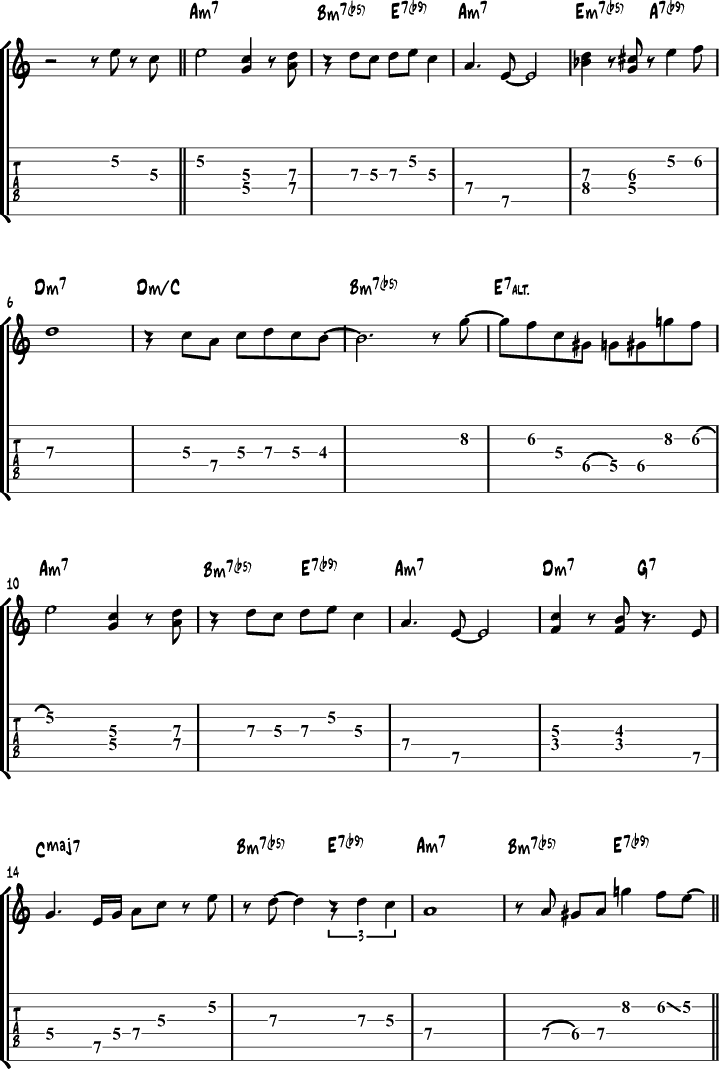
Summertime Scales
There are 2 guitar scales that can be used over the entire chord changes of Summertime, the A natural minor scale and the A minor blues scale.
A Natural Minor Scale
The first is the A natural minor scale (aka A Aeolian scale). This scale has the same notes as the C major scale.
| A Natural Minor Scale | A | B | C | D | E | F | G |
|---|---|---|---|---|---|---|---|
| 1 | 2 | b3 | 4 | 5 | b6 | b7 |
Here is the most common fingering on guitar (but always learn to play all guitar scales over the entire fret board):
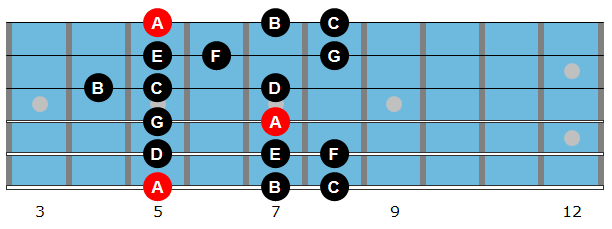
A Minor Blues Scale
The minor blues scale has the same notes as the A minor pentatonic scale, but with an added blue note.
| A Minor Blues Scale | A | C | D | D# | E | G |
|---|---|---|---|---|---|---|
| 1 | b3 | 4 | #4 | 5 | b7 |
Here is the most common fingering:

You can get by using only these 2 scales in your improvisation, but your solos will sound repetitive and not very interesting. One way to spice things up a bit is to add some other scales, especially over the dominant chords…
D Minor Harmonic Scale
This scale can be used in the 4th bar, over the ii V in D minor (Em7b5 A7):
| D Minor Harmonic Scale | D | E | F | G | A | Bb | C# |
|---|---|---|---|---|---|---|---|
| Played over A7 | 11 | 5 | b13 | b7 | 1 | b9 | 3 |
Here is the fingering in 5th position:

The harmonic minor scale can also be played over the ii Vs in A minor, but here we have to use the A harmonic minor scale:

Summertime Arpeggios
Another way to add interest to your solos is using arpeggios. While explaining how arpeggios work is beyond the scope of this lesson, here’s one example you can use over the ii V in D minor in the 4th bar.
A common arpeggio to play over a dominant chord is the diminished arpeggio starting on the 3rd of that dominant chord.
For example, you can play a C#dim7 arpeggio over A7:
| C#dim7 Arpeggio | C# | E | G | Bb |
|---|---|---|---|---|
| Played over A7 | 3 | 5 | b7 | b9 |
Here’s a possible fingering:
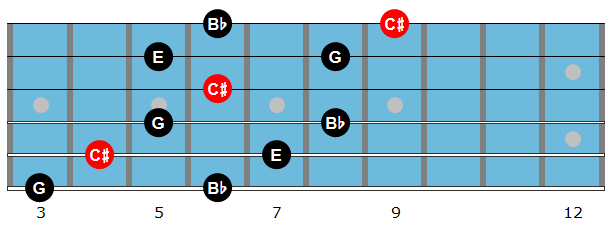
If you want to learn more about using arpeggios in your solos, check out The Easy Guide to Jazz Guitar Arpeggios.
Summertime Backing Track
Here’s a backing track you can use to practice:
Summertime Solo Study Chorus 1 [0:35 in the video]
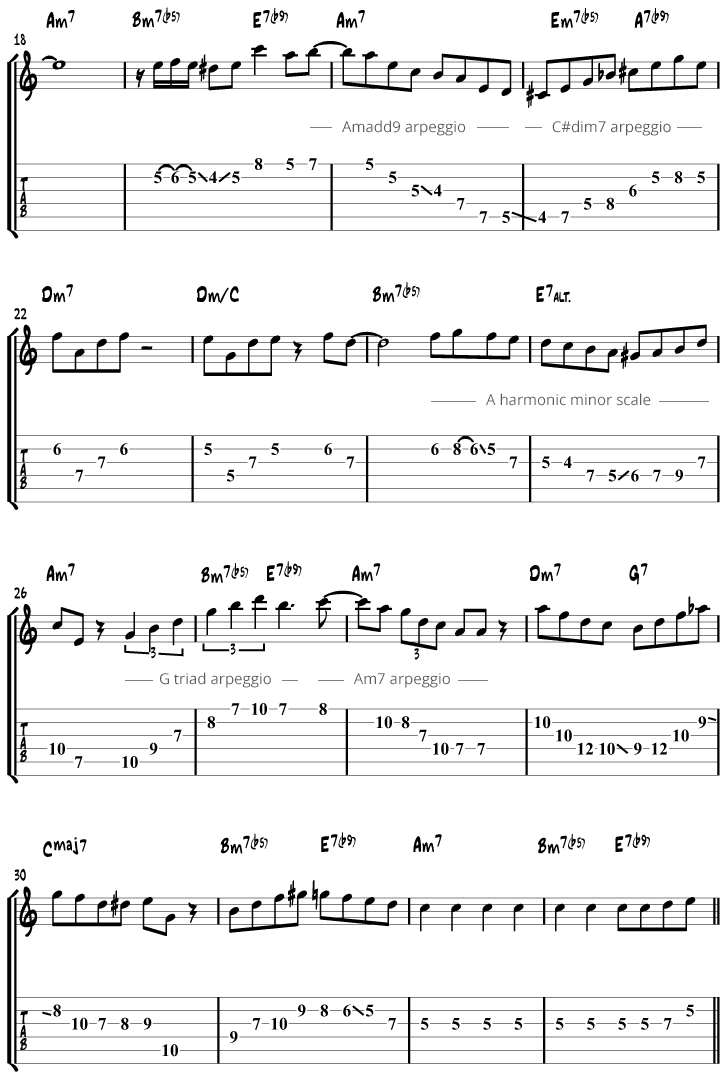
Bar 20: here I use an Am(add 9) arpeggio:
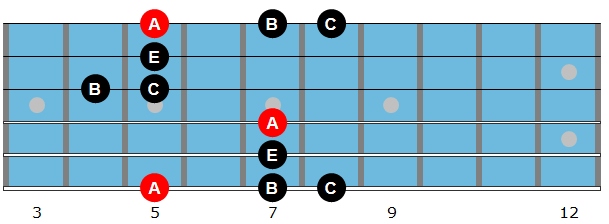
Bar 26: here I use a G triad arpeggio:
| G arpeggio | G | B | D |
|---|---|---|---|
| Played over Am7 | b7 | 9 | 11 |
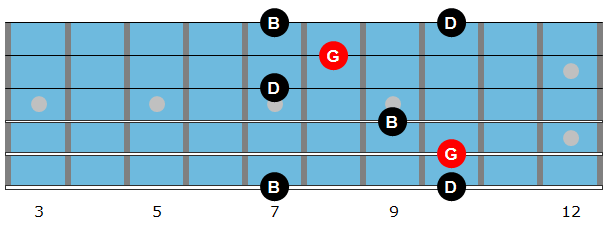
Summertime Solo Study Chorus 2 [1:02 in the video]
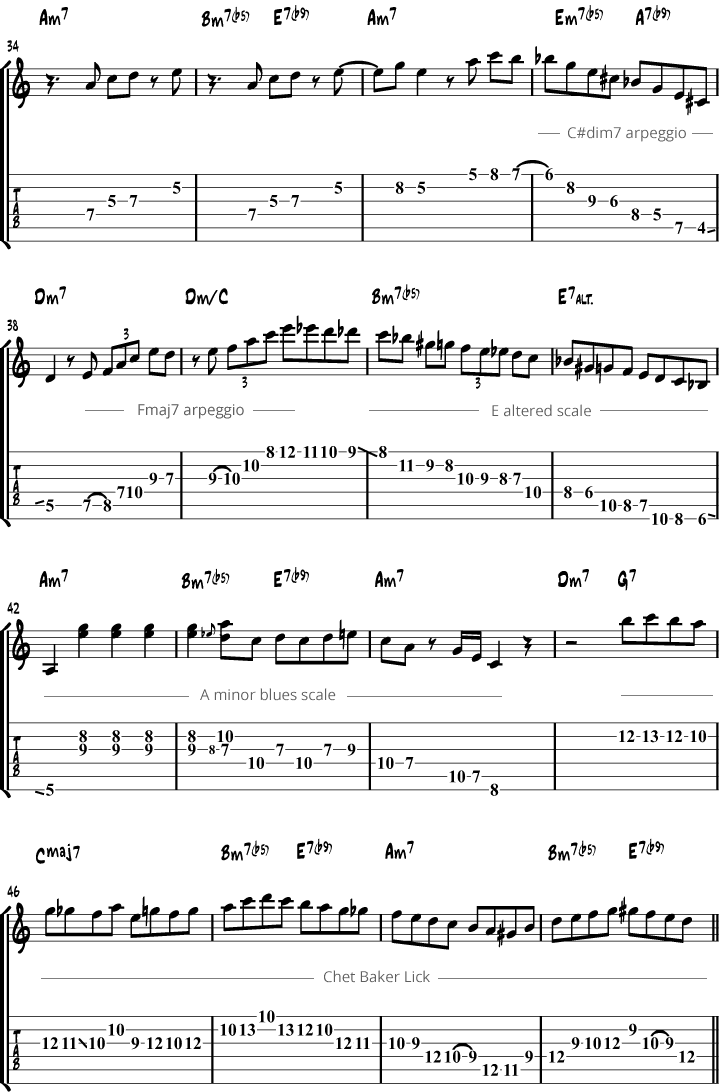
Bar 38: here I play an Fmaj7 arpeggio over Dm7.
When playing over minor chords, play a maj7 arpeggio starting on the 3rd of that minor chord to get a 9 sound.
| Fmaj7 arpeggio | F | A | C | E |
|---|---|---|---|---|
| Played over Dm7 | b3 | 5 | b7 | 9 |
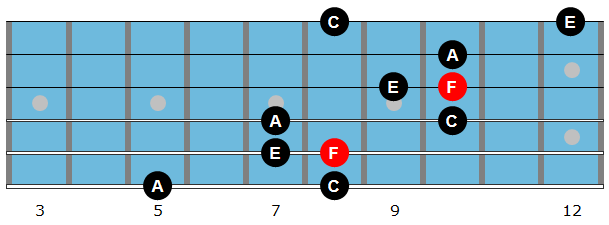
Bar 40: here I play the E altered scale, with a chromatic note in between (click here to learn how to use the altered scale).
| E Altered Scale | E | F | G | G# | Bb | C | D |
|---|---|---|---|---|---|---|---|
| 1 | b9 | #9 | 3 | b5 | b13 | b7 |

Bar 45: this is a Chet Baker phrase.
Summertime Solo Study Chorus 3 [1:30 in the video]
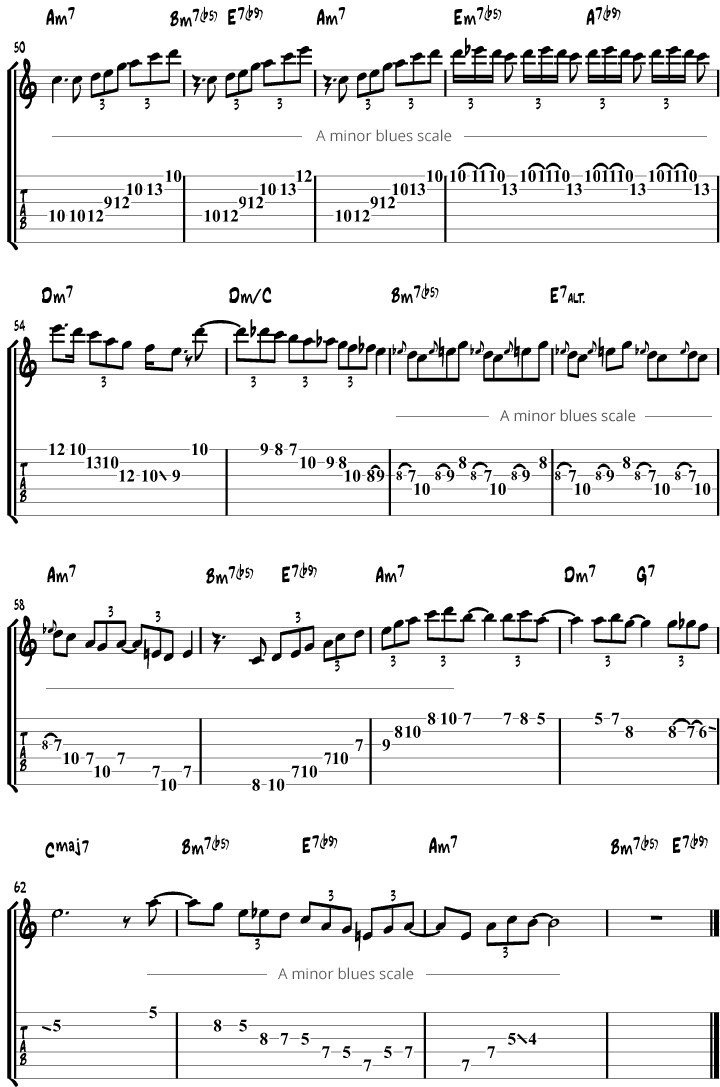


Thank You, Dirk! Your lessons are inspirative and motivating.
What a tremendous help for beginniners. great work, dirk
Dirk, thank you so much for this lesson. It’s really good!
where can I find a full BT?
The backing track is above solo study chorus 1.
Hello Dirk, is the guitar pro file available? Thanks for your marvellous work on jazz music.
What’s the tempo?
Hi, the tempo is 140 BPM.
Wow I’m so happy to have found this!
Dirk, thanks so much for your awesome lessons!
Have you considered doing a count in instead of just having the audio start right up at the point you’re supposed to be playing? You don’t have enough time to play the beginning notes and get the rest of it in the screenshot. Thanks
Dank u Dirk,
De beste site om jazz te leren!
Mvg
Ronny Maes
Bedankt voor de feedback, Ronny!
Thanks this is a beautiful lesson!
nice way of teaching. thanks a million !!!!👍
Thanks for the excellent lesson on a great tune Dirk! Really enjoying your site.
Thanks 🙏🙏🙏❤️❤️
Great lesson! The notation is incorrect for Bars 55 (that F-flat, vs the tab) and 64 (wrong rhythm). Just wanted to let you know because it’s been a big help to me!
Excellent blog for real musicians
lezioni splendide .grazie
Glad you dig our lessons, Felice!
I like the lessons, but i havent conditions to buy the Ebooks, someone please help me.
Très bel arrangement avec une belle sonorité et une telle facilité d’exécution! Je suis jaloux!!!Lol
Really Nice again!
You play this beautifully, I would really like to know how you get that nice mellow tone. I know tone is also how the player touches the notes (both left hand and right hand) but what suggestions would you have. Interested in knowing what amp your using and any pedals you us, settings on amp and guitar. Thank you so much.
basically set your mids max bass max or 3/4 and treble 1/2 and on your guitar turn your tone knob all the way down for such an extreme sound anyway that works for me
i hope i could help
I think a big part of the jazz tone is cutting frequencies. I’d suggest cutting any frequencies under 200hz to get rid of any bass rumble and over 4k Hz. I can get the right tone from spending lots of time in the studio. Now just to work on the playing 🙂
I really like how you have put this lesson together, thanks much!!
Thanks for the feedback Steve!
Gracias por esta leccion muy bueno
Nice post!!! I can’t download the backing rack though, there seems to be a server error
Hi Miles, this should be fixed now, please try and let me know…
Hi Dirk,
Thank you, you do so much work for us. I have been with you since the early days and you are always giving more and teaching new material. For the Love of Jazz…You Are Great. Ill get some one day to repay your kindness, and i will buy from you. All the best. Matt Hawkins.
This is an excellent jazz guitar improvisation lesson. The solo was was well done with good lines, good tone and good variation in the feel of the improv
Thank you for this wonderful lesson!
Great lesson Dirk
Thanks so mutch
Many Thanks Dirk!
Really looking forward to practice over the weekend now!
Amazing!
Hallo Dirk,
Ik ben momenteel met vakantie.
Na de vakantie pak ik de gitaar weer. Summertime is een heerlijk nummer. Na de vakantie ga ik mij daar zeker in verdiepen.
Dank je wel voor de info.
Good morning, Dirk.
I’ve had a quick skim through this, and I’m looking forward to getting my teeth into it, but I have one comment to make about your description of the C# diminished arpeggio over an A7 chord.
The reason this arpeggio works, and the way it functions as a replacement for a dominant seventh chord, is that it’s actually an A7b9 arpeggio that misses out the root. When I hear a diminished chord or arpeggio in context, it feels transitional to me – providing a stepping stone from one chord to the next. A dominant seventh has a different feel and function.
Obviously there’s a tension in your lessons between the pragmatic (“this is where to find this arpeggio during a solo”) and the theoretical (“this is what’s really happening here”), but we’re big boys and girls on this forum, and I think we can take a little theory!
My tip for finding where to start this arpeggio it to play the root first and slide up a semitone (to Bb in this case) before starting the familiar sequence of minor third intervals.
A similar chord-naming issue arises with Em7b5, C9 and Gm6, where the same shape is used but is (usually!) given the name that fits its function.
Thank you so much, Dirk. One of your best lessons, definitely. Wonderful tone and sound. So jazzy!
Great Lesson, thank you very much!!